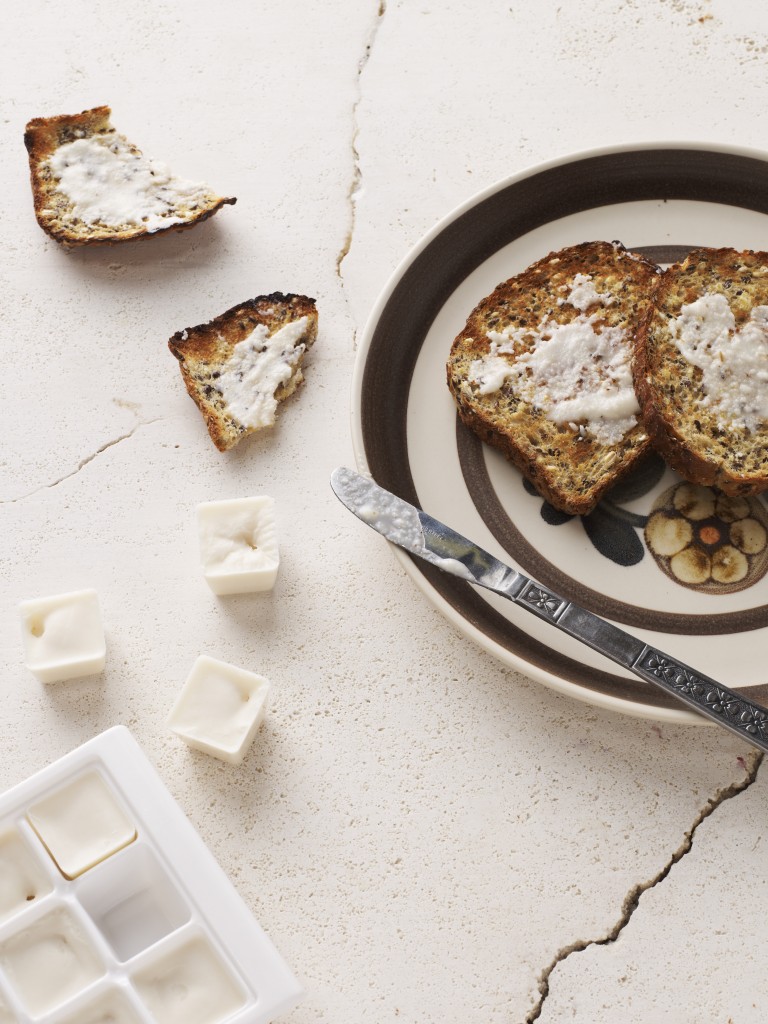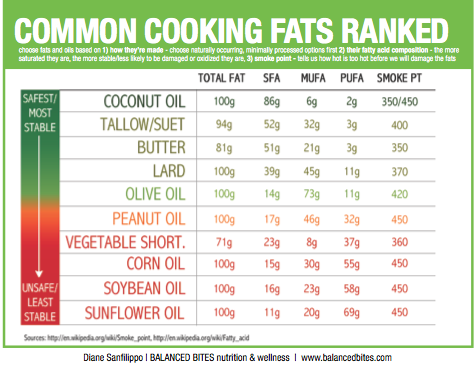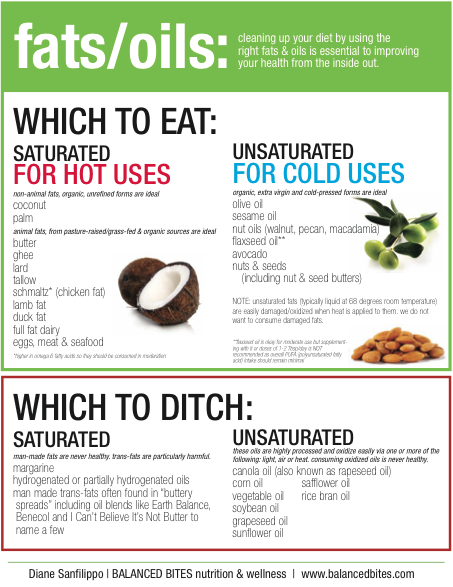Heaps of you have asked me to do a post that spells out what fats to eat, and when and how. So here we go.

First, let’s acknowledge the information out there is conflicted. More and more the scientists and chefs and wellness nuts are agreeing: the fats we’ve been told to eat for the past 50 years – the poly-unsaturated, so-called “vegetable” ones – are, in fact, the worst stuff we can put in our bodies. And the fats we’ve been told to never touch – the saturated ones – are actually the healthiest, safest and, in fact, are the least “fattening” (if you’re not eating a sugar and carb-heavy diet while also eating fat).
Learn more by reading my post on how the science now shows saturated fat is good for us.
I’ve been following the debates for a bit, weighing up what’s right. Here are some of the issues explained and a rundown on how I eat my fat:
some science to get started
Whether a fat is safe to eat is based on two things:
- its smoke point (higher the better)
- its stability (the more stable the better), which is determined by what kind of carbon, hydrogen and oxygen bonds it has.
Smoke points explained:
All fats are made up of hydrogen, oxygen and carbon but arranged in different orders. Each carbon atom is bonded to two other carbon atoms, and the more carbon atoms in a fatty acid, the longer it will be. Ergo short and long chains.
Longchain fatty acids = higher melting/smoke point
The more refined the oil, the higher the higher melt or smoke point, which means the oil is much better for you. A fat is no longer good for consumption after exceeding it’s smoke point, as it begins to break down, and releases toxic fumes and free radicals. The longer it takes the oil to smoke, the better.
Stability explained:
Chains with carbon atom bonded to two hydrogen atoms = a saturated fat (each carbon molecule is “saturated” with hydrogen) = more stable = solid at room temperature.
Chains with has carbon bonded to only one hydrogen and double bonded to another carbon = monounsaturated fat = not so stable = liquid at room temperature.
Chains with has carbon bonded to only one hydrogen but with several double bonds = a polyunsaturated fat = very unstable = liquid at room temperature.
I mostly eat saturated fat
We are mostly made up of saturated fat. This is what we’re meant to eat. Saturated fats are crucial for absorbing vitamins, calcium uptake, immune function, and cell membrane structure. Eating the right saturated fats lead to increased tolerance to the sun, skin issues like acne or eczema clear up, drastically increased energy, absence of food cravings, and peaceful sleep. And they can make you lose weight. Yes. That’s been my experience since I’ve upped my saturated fat levels.
I eat meat fat (chicken skin and pork crackling) and lots of coconut products.
I cook with bacon lard (left over from frying bacon), coconut oil and ghee
I eat a little monounsaturated fats
These should never be heated to high temperatures as this can cause breakdown and free radicals. Check out my chat with David Gillespie on this here.
I eat (cold/unheated) olive oil, avocado oil, macadamia oil.
I cook olive oil at medium temperatures only (not frying).
However, I do cook with macadamia oil (which has a very high smoke point).
I avoid polyunsaturated fats
These are the so-called vegetable oils, though they’re actually from grains and beans. They go rancid easily and break down into free radicals when heated.
Worse, most of these oils go through a hydrogenation process to make them last as long as the saturated fats, but this very process makes them basically unusable to the body, causing all kinds of health problems.
I don’t add omega oils
We should be eating the omegas – Omega 6 (found in grains, corn, and animals fed grains and corn, corn and soybean oil) and Omega 3 (found in fish, nuts etc) in a 3:1 ratio. Sadly, most people today consume a ratio of 35:1. The fix to this issue? We’re told to eat Omega 3 supplements. As I discuss with David Gillespie here, this is madness. It doesn’t work. Far better to cut our Omega 6 intake instead.
Also, Omega 3 oils we’re told to eat, like flaxseed, are very unstable and turn rancid fast. Although there does seem to be some worth to the argument that Krill oil is a good way to go.
I personally don’t take these supplements – I eat more fish and nuts and cut out the processed grains.
I don’t touch transfats
These are unsaturated fats that have been turned into much more dangerous fats by changing the placement of the hydrogen atoms in the molecule. These fats are able to be absorbed by individual cells and mess up the function of the cell.
I will eat sugar before I eat transfats…which says a lot.
For some extra reading, you might like to check out this great interview with the authors of a new book “Why Women Need Fat,” Steven J.C. Gaulin, an evolutionary biologist, and William D. Lassek, a retired doctor of public health at the University of Pittsburgh. It gives a cheery take on fat and the differences between the ways women and men gain weight.
Some bits I liked:
Why women put on weight after a few kids:
“Interestingly, human brain size plays a big role in why women need fat and why they tend to gain weight after having children. Humans have ridiculously big brains, which makes it more difficult to give birth to our infants. While chimps, orangutans and gorillas can literally sleep through a birth, human births, especially first births, are typically more than a day of very difficult labor. Women tend to weigh less before they have had their first baby because with a first infant, evolutionarily, it pays not to grow a baby that is too large. They can get stuck in the birth canal. It’s not so much of a problem for us in 21st-century North America because most women have fairly ready access to cesarean section. But for 99.99 percent of human evolution, it was a really big problem. The result of natural selection is that women tend to be lighter before they have a child because they need their first infant to be smaller in order to survive childbirth. Each infant that a woman has remodels the pelvis so that each subsequent infant can grow somewhat bigger. There is a positive correlation between birth order and birth weight. So the way to grow a bigger infant is for the mother to have more fat on her body.”
On the “polyunsaturated explosion”:
“Two people (exerted) a very big influence on our national diet. One was coming from an economic perspective and the other was coming from (what he believed) was a nutritional perspective. After Dwight Eisenhower had a major heart attack, when the American public became much more focused on heart health and nutrition, a popular nutritionist by the name of Ansel Keys made a lot of impact. He was committed to the notion that saturated fat was the culprit in the heart disease epidemic in the U.S. He advised Americans to replace saturated fat with polyunsaturated fats, in particular corn and soybean oils. Meanwhile Earl Butz, Nixon’s secretary of agriculture, had been tasked to get food prices lower. He decided to heavily subsidize and commoditize corn and soybeans in order to make them really cheap. So corn and soybeans became the basis of our entire food production system. And it continues today. The amount of these oils in the American diet increases significantly every year.
Why omega-6 is to blame for unnatural fat gain
It’s not bad to eat grains, it’s not bad to eat corn, and it’s not bad to eat soybeans. What is bad is that food processors extract and concentrate these oils from plants. In an ear of corn there isn’t that much corn oil, but when you subject it to industrial processing and extract everything but the oil, now you’ve got a lot of omega-6. It’s this heavy industrial processing of seed crops that makes our diet so unnatural. Omega-6s make us fat in a variety of ways. They promote fat storage. Omega-6 is also the precursor for certain signaling molecules called endocannabinoids. Will likes to call them the body’s home-grown version of marijuana. Endocannabinoids give you the munchies just like cannabis does. So the omega-6s are telling the body, “Store the fat you have.” And they are also telling the body, “Eat more, I’m hungry!
How to eat to not put on weight:
Start eating the kind of diet that drastically reduces the amount of polyunsaturated omega-6s in the diet. The best way to do that is to stop eating processed food and to avoid commercially fried foods because they are always fried in these omega-6 fats. Potato and corn chips, for example, are a huge contributor of omega-6s in the diet. There is more than a gram of omega-6 in every single potato chip that a person eats.
And if you’d like to get hold of my I Quit Sugar Cookbook, simply click on the button below.
Over and out…feel free to add your fatty thoughts below.




